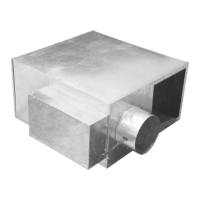14
BALANCING 45M,N,R PARALLEL FLOW UNITS
A parallel fan terminal is designed to operate with the fan supply-
ing air equal to 40 to 60% of the VAV damper maximum setting.
Adjustments to the parallel units fan should be made with the pri
-
mary air closed off. Refer to unit capacity tables to ensure airflow
through the electric heater meets the minimum requirements
before operating heater.
Each control option has specific procedures required for balancing
the unit, but some steps are common to all parallel fan units, as de
-
scribed below.
To balance parallel fan unit:
Setting Fan Airflow
NOTE: If the unit has electric heat or hot water heat, temporarily
disable these functions before balancing the fan.
If unit has optional electric heat disconnect downstream of fan
motor connections to power, open disconnect.
If unit does not have optional electric heat disconnect, remove one
electric heat power line connection. Be sure to insulate loose line
from ground wire or other wires.
1. Set the controller to provide heating airflow demand only.
Typically, this is accomplished by setting the thermostat to
the highest possible temperature setting.
NOTE: A minimum of 0.1 in. wg downstream static pressure
is required in the duct to ensure proper heater operation.
2. Determine that the VAV damper is fully closed. This may
require a temporary override of the VAV controller. Do not
adjust minimum and maximum cfm set points at this time.
3. Using a flow hood or duct traverse, determine the deliv-
ered fan airflow (cfm).
NOTE: Both flow hood and duct traverse are subject to mea-
surement errors. Be sure that all applicable measurement pre-
cautions are taken.
4. Compare the required design cfm in heating mode to the
actual delivered airflow. If there is a minimum setting for
the VAV damper in heating mode (as recommended by
ASHRAE [American Society of Heating, Refrigeration,
and Air Conditioning Engineers] Standard 62), this quan
-
tity is included in the total measured airflow.
5. Adjust the fan SCR at unit control box to achieve the
desired airflow rate.
Setting VAV (Primary) Airflow
Set Point Adjustments
Each parallel fan unit is equipped with a pneumatic or electronic
volume controller which regulates the quantity of cold primary air
entering the terminal and the conditioned space. If required air
-
flow levels are specified with the job order, the minimum and
maximum cfm levels will be set at the factory. If minimum and
maximum levels are not specified, a default value is used. Other
settings of minimum and maximum primary airflow must be set in
the field. Airflow (cfm) ranges for the primary air damper are
shown in Tables
12-14 for 45M,N,R units. The minimum primary
airflow (other than zero) is the minimum flow rate controllable by
the unit volume controller. The primary air damper can be set at
zero for shutoff or at the minimum cfm listed.
Min and Max Airflow Set Points — Field Adjustments
Each parallel fan unit is equipped with a four quadrant multi-point
center averaging airflow sensor which provides an amplified dif
-
ferential pressure that is proportional to the unit airflow. Output
from this probe is used to provide a flow signal to both pneumatic
and electronic controls. Unit airflow (cfm) can be read directly
from the flow probe on the unit.
1. After the unit airflow from the fan has been set, turn on
primary (VAV) air supply and turn off the fan.
2. To set cfm in the field, connect a gauge to the flow probe
and check the differential pressure.
3. If a minimum VAV flow is required in heating mode,
adjust the volume controller until the differential pressure
corresponds to the cfm required.
4. Some control sequences allow the fan to start before the
VAV damper reaches minimum setting, for an overlapping
of fan and VAV flow. For these sequences, after controller
minimum airflow has been adjusted, the total airflow with
both fan and primary airflow should be checked. For
sequences that call for the fan to start as the first stage of
heat, the cooling minimum cfm can be verified at the dif
-
fuser.
Setting the minimum control point will typically require care-
ful adjustment of the thermostat to create a minimum cooling
demand signal.
5. Set the controller to provide maximum cooling demand.
This is typically accomplished by setting the thermostat to
the lowest possible temperature setting. For most control
sequences, this will cause the fan to shut off.
Adjust the volume controller until the differential pressure
(measured through the flow probe as described above) corre-
sponds to the cfm required.
6. Return all reheat options to normal connections.
7. Cap the ends of the inlet flow sensors.
8. Reset the thermostat to a normal setting.

